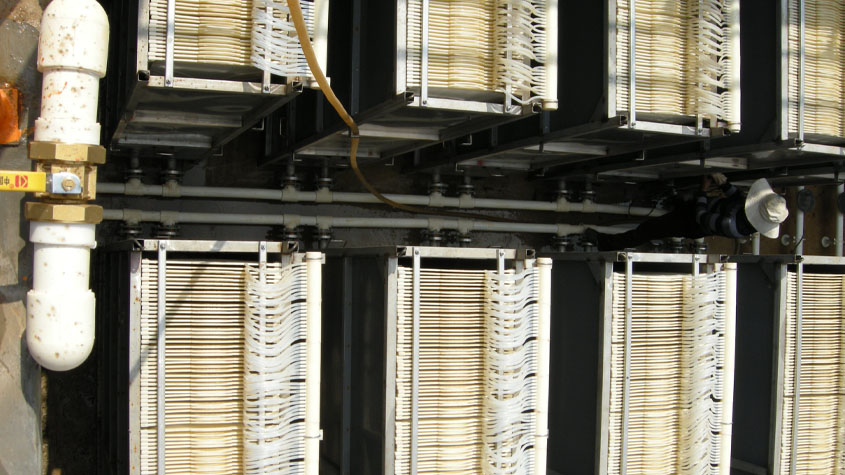
Water scarcity is a pressing global issue, with many regions facing limited access to freshwater resources. Desalination, the process of converting seawater or brackish water into freshwater, has emerged as a viable solution to address water scarcity. Submerged flat sheet membrane modules have revolutionized desalination processes, offering efficient and sustainable solutions. This article explores how submerged flat sheet membrane modules are addressing water scarcity through desalination, highlighting their benefits, applications, and contributions to achieving reliable and high-quality freshwater production.
1. The Global Water Scarcity Challenge:
Water scarcity affects millions of people worldwide, impacting human health, agriculture, and economic development. As freshwater sources become increasingly limited, desalination has emerged as a crucial technology to provide a sustainable and reliable water supply.
2. Introduction to Submerged Flat Sheet Membrane Modules for Desalination:
Submerged flat sheet membrane modules are innovative filtration systems that utilize flat sheet membranes with microscopic pores to separate salt and impurities from seawater or brackish water. These modules are submerged in the water to be treated, allowing for continuous filtration and efficient desalination. The small pore size of the membranes ensures the removal of salt ions and other impurities, resulting in the production of high-quality freshwater.
3. Benefits of Submerged Flat Sheet Membrane Modules for Desalination:
a) High Desalination Efficiency: Submerged flat sheet membrane modules offer exceptional desalination efficiency, effectively removing salt ions and other impurities from seawater or brackish water. The membranes’ small pore size ensures the production of high-quality freshwater, meeting stringent water quality standards.
b) Energy Efficiency: Submerged flat sheet membrane modules are designed to operate at low pressures, reducing energy consumption compared to other desalination technologies, such as reverse osmosis. This enhances the overall energy efficiency of desalination processes, making them more sustainable and cost-effective.
c) Space-Efficient Design: Submerged flat sheet membrane modules have a compact design, making them suitable for installation in various desalination plants, including seawater desalination plants and small-scale decentralized systems. This flexibility allows for efficient use of available space and enables the implementation of desalination projects in diverse settings.
d) Reliable Operation: The submerged configuration of membrane modules ensures continuous filtration, minimizing downtime for maintenance and maximizing the productivity of desalination plants.
4. Applications of Submerged Flat Sheet Membrane Modules in Desalination:
a) Seawater Desalination: Submerged flat sheet membrane modules play a crucial role in large-scale seawater desalination plants, producing freshwater from abundant seawater resources. These modules effectively remove salt ions and other impurities, ensuring the delivery of high-quality freshwater for various applications, including drinking water supply and irrigation.
b) Brackish Water Desalination: Submerged flat sheet membrane modules are also utilized in desalination processes for brackish water. They effectively remove salt ions and other impurities, converting brackish water into freshwater suitable for various non-potable uses, such as industrial processes or agricultural irrigation.
5. Contribution to Sustainable Water Management:
The adoption of submerged flat sheet membrane modules in desalination aligns with the principles of sustainable water management:
a) Water Conservation: Desalination using submerged flat sheet membrane modules allows for the utilization of abundant seawater or brackish water resources, reducing the demand for freshwater sources and alleviating water scarcity issues.
b) Energy Efficiency: The low-pressure operation of submerged flat sheet membrane modules reduces energy consumption, making desalination processes more sustainable and cost-effective. This helps minimize the environmental impact associated with energy consumption and promotes the use of renewable energy sources in desalination plants.
c) Minimized Environmental Impact: Submerged flat sheet membrane modules for desalination minimize the environmental impact by reducing the need for chemical additives and minimizing the discharge of brine into the environment. This promotes cleaner and more sustainable desalination practices.
Conclusion:
Submerged flat sheet membrane modules have revolutionized desalination processes, offering efficient and sustainable solutions to address water scarcity. Their high desalination efficiency, energy efficiency, space-efficient design, and reliable operation contribute to reliable and high-quality freshwater production. By adopting submerged flat sheet membrane modules, desalination plants can provide a sustainable and reliable water supply, ensuring access to clean and safe freshwater for various applications. As the global water scarcity challenge persists, submerged flat sheet membrane modules will continue to play a vital role in addressing water scarcity through desalination, contributing to sustainable water management and promoting a more water-secure future.
About Jiangsu Peier membrane
Jiangsu Peier membrane corp.,Ltd(Stock Code: 836744) was established in 2007 with a registered capital of 48 million Yuan, referred to as “Peier membrane industry”.
It is a high-tech enterprise focusing on the R&D, production, manufacturing and service of MBR flat sheet membrane products. Its Peier Product category as below:
- Flat Sheet Membrane Element
- Flat Sheet Membrane Element-Single Nozzle
- Flat Sheet Membrane Element-Double Nozzle
- Flat Sheet Membrane Element-3D Soft Support
- Flat Sheet Membrane Element-Renovated Membrane
- Flat Sheet Membrane Module
- Flat Sheet Membrane Module-Module-Single Nozzle
- Flat Sheet Membrane Module-Module-Double Nozzle
- Flat Sheet Membrane Module-2S(Double Deck)
- Flat Sheet Membrane Module-3S(High Flux)
- Flat Sheet Membrane Module-Mini Module
- MBR System
- MBR System-Laboratory Test Equipment
- MBR System-Pilot Equipment
- MBR System-Package System
Peier membrane always adheres to R&D and cooperation with well-known universities at home and abroad, such as Tsinghua University, Sydney University, Nanjing University of technology, Changzhou University and Jiangnan University.
It is the editor in chief of the national industry standard HY/T252-2018 “submerged flat membrane element for water treatment”.
At present, it has 7 invention patents, 56 new utility patents, 4 software works and 1 appearance patent.